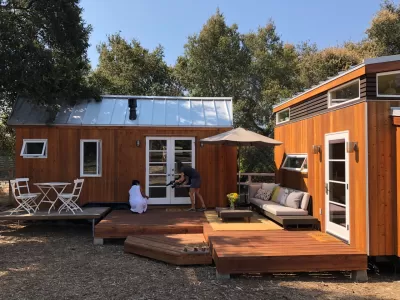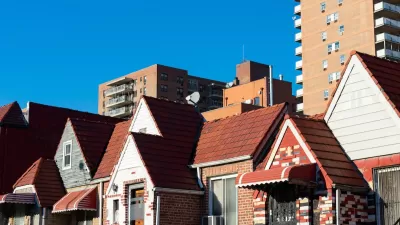A few jurisdictions have gone beyond conformity with state law to encourage the construction of accessory dwelling units in the state of California, like in San Diego.

Cinnamon Janzer reports on San Diego County's approach to Accessory Dwelling Units, deployed last fall to further support ADU development beyond the allowances made by state law, by "offering free, pre-approved ADU floor plans and waiving $15,000 in permit and development fees to reduce the costs associated with construction."
Janzer quotes Gary Geiler, the development services director for the city of San Diego, to explain what the city is doing to support ADU construction in a city with notoriously high housing prices, much like the rest of the cities in the state.
“We’ve had companion unit regulations on the books since the 90s,” Geiler says, “but they were more design-oriented and required conditional use permits. We didn’t get a lot of applications, maybe 10 in a year.” These days, those numbers are way up. “In 2017… we got an increase of over 100 applications that first year, so we said, ‘OK, we’re onto something here.’” The city has since done away with even more fees. “The applications increased even further,” Geiler says. “We had probably over 300 applications in 2018 and over 600 in 2019. So far we have about 200 new units this year and about 1,000 units applied for.”
Janzer also speaks with Caitlin Bigelow, a resident of the nearby city of La Mesa, who started the company Maxable to offer ADU consulting and services to Californians, who finds room for improvements for both the city and the county's efforts, finding fault especially with the pre-approved floor plans, and points to the example of San Jose for a model for improvement.
"She’d like to see San Diego take an approach more like San Jose’s where the city opened up the plan design process to local design professionals and created something of a library of plan choices that offer more variety to meet the needs of different homeowners," reports Janzer.
FULL STORY: San Diego Aims to Spur More Backyard Homes with Free Floor Plans

Manufactured Crisis: Losing the Nation’s Largest Source of Unsubsidized Affordable Housing
Manufactured housing communities have long been an affordable housing option for millions of people living in the U.S., but that affordability is disappearing rapidly. How did we get here?

Americans May Be Stuck — But Why?
Americans are moving a lot less than they once did, and that is a problem. While Yoni Applebaum, in his highly-publicized article Stuck, gets the reasons badly wrong, it's still important to ask: why are we moving so much less than before?

Using Old Oil and Gas Wells for Green Energy Storage
Penn State researchers have found that repurposing abandoned oil and gas wells for geothermal-assisted compressed-air energy storage can boost efficiency, reduce environmental risks, and support clean energy and job transitions.

Updating LA’s Tree Rules Could Bring More Shade to Underserved Neighborhoods
A new USC study finds that relaxing Los Angeles’ outdated tree planting guidelines could significantly expand urban tree canopy and reduce shade disparities in lower-income neighborhoods, though infrastructure investments are also needed.

California's Canal Solar Projects Aim to Conserve Resources and Expand Clean Energy
California’s Project Nexus has begun generating electricity from solar panels installed over irrigation canals, with researchers and state agencies exploring statewide expansion to conserve water and boost clean energy production.

HHS Staff Cuts Gut Energy Assistance Program
The full staff of a federal program that distributes heating and cooling assistance for low-income families was laid off, jeopardizing the program’s operations.
Urban Design for Planners 1: Software Tools
This six-course series explores essential urban design concepts using open source software and equips planners with the tools they need to participate fully in the urban design process.
Planning for Universal Design
Learn the tools for implementing Universal Design in planning regulations.
Heyer Gruel & Associates PA
City of Moreno Valley
Institute for Housing and Urban Development Studies (IHS)
City of Grandview
Harvard GSD Executive Education
Salt Lake City
NYU Wagner Graduate School of Public Service
City of Cambridge, Maryland





























